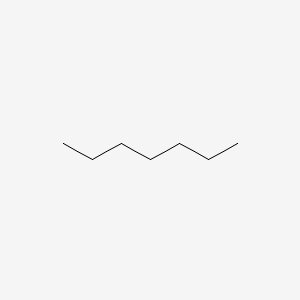| MeSH term | MeSH ID | Detail |
|---|---|---|
| Dermatitis, Contact | D003877 | 59 associated lipids |
| Sarcoma 180 | D012510 | 21 associated lipids |
| Occupational Diseases | D009784 | 42 associated lipids |
| Weight Gain | D015430 | 101 associated lipids |
| Leukemia | D007938 | 74 associated lipids |
| Peripheral Nervous System Diseases | D010523 | 33 associated lipids |
| Anemia, Sickle Cell | D000755 | 34 associated lipids |
| Hepatitis A | D006506 | 8 associated lipids |
| Hemophilia A | D006467 | 10 associated lipids |
| Hemophilia B | D002836 | 3 associated lipids |
Heptane
Heptane is a lipid of Fatty Acyls (FA) class. The involved functions are known as cell activation and Synthesis. Heptane often locates in immunological synapse.
Cross Reference
Introduction
To understand associated biological information of Heptane, we collected biological information of abnormalities, associated pathways, cellular/molecular locations, biological functions, related genes/proteins, lipids and common seen animal/experimental models with organized paragraphs from literatures.
What diseases are associated with Heptane?
There are no associated biomedical information in the current reference collection.
Possible diseases from mapped MeSH terms on references
We collected disease MeSH terms mapped to the references associated with Heptane
PubChem Associated disorders and diseases
What pathways are associated with Heptane
There are no associated biomedical information in the current reference collection.
PubChem Biomolecular Interactions and Pathways
Link to PubChem Biomolecular Interactions and PathwaysWhat cellular locations are associated with Heptane?
Visualization in cellular structure
Associated locations are in red color. Not associated locations are in black.
Related references are published most in these journals:
| Location | Cross reference | Weighted score | Related literatures |
|---|
What functions are associated with Heptane?
Related references are published most in these journals:
| Function | Cross reference | Weighted score | Related literatures |
|---|
What lipids are associated with Heptane?
There are no associated biomedical information in the current reference collection.
What genes are associated with Heptane?
There are no associated biomedical information in the current reference collection.
What common seen animal models are associated with Heptane?
There are no associated biomedical information in the current reference collection.
NCBI Entrez Crosslinks
All references with Heptane
Download all related citations| Authors | Title | Published | Journal | PubMed Link |
|---|---|---|---|---|
| Müller M et al. | Development of solvent systems with room temperature ionic liquids for the countercurrent chromatographic separation of very nonpolar lipid compounds. | 2017 | J Chromatogr A | pmid:28179081 |
| Takó M et al. | Purification and Properties of Extracellular Lipases with Transesterification Activity and 1,3-Regioselectivity from Rhizomucor miehei and Rhizopus oryzae. | 2017 | J. Microbiol. Biotechnol. | pmid:27780957 |
| Orlandini S et al. | An integrated quality by design and mixture-process variable approach in the development of a capillary electrophoresis method for the analysis of almotriptan and its impurities. | 2014 | J Chromatogr A | pmid:24656544 |
| Kuchlyan J et al. | Effect of confinement on excited-state proton transfer of firefly's chromophore D-luciferin in AOT reverse micelles. | 2014 | J Phys Chem B | pmid:24624892 |
| Trivella AS et al. | Perinaphthenone phototransformation in a model of leaf epicuticular waxes. | 2014 | J. Photochem. Photobiol. B, Biol. | pmid:24300996 |
| Saun NK et al. | Comparative study of free and immobilized lipase from Bacillus aerius and its application in synthesis of ethyl ferulate. | 2014 | J Oleo Sci | pmid:25099909 |
| Hamzaoui M et al. | Stepwise elution of a three-phase solvent system in centrifugal partition extraction: a new strategy for the fractionation and phytochemical screening of a crude bark extract. | 2013 Jul-Aug | Phytochem Anal | pmid:23427023 |
| Pati AK et al. | Deciphering the photophysical role of conjugated diyne in butadiynyl fluorophores: synthesis, photophysical and theoretical study. | 2013 | J Phys Chem A | pmid:23822662 |
| Banerjee C et al. | Curcumin in reverse micelle: an example to control excited-state intramolecular proton transfer (ESIPT) in confined media. | 2013 | J Phys Chem B | pmid:23687942 |
| Johnson M et al. | Time-resolved infrared studies of a trimethylphosphine model derivative of [FeFe]-hydrogenase. | 2013 | J Phys Chem B | pmid:24083980 |
